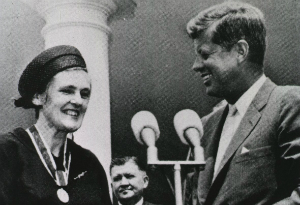International Day of Women & Girls in Science: 5 women who changed science
- Emma Finamore
- 23 Feb 2016
Can you imagine life without GPS or wifi? No, neither could she.

Starting this year, 11 February will be recognised as a global celebration of equal participation and the accomplishments of female researchers across all aspects of science education, training, employment and decision-making processes.
To celebrate the first of these important annual celebrations, here’s a run-down of five women who changed science forever.
1. Hedy Lamarr (1914 – 2000)
Austrian-American film actress, Hedy Lamarr, was known in her heyday as "the most beautiful woman in the world", but she was also the inventor of the precursor to the type of wireless communications used today in mobile phones, GPS and wi-fi.
Working with composer George Antheil, Lamarr developed a radio guidance system for torpedoes that used "frequency hopping" to stop transmissions being jammed or intercepted.
The pair patented a frequency-hopping device and donated their invention to the US navy.
The invention was not used during World War II, but the idea was revived in the 1950s and became the inspiration for spread-spectrum technology that is the basis of modern-day wireless communications.
2. Beatrix Potter (1866 – 1943)
Best known for her work as a children's author (and creator of everyone’s favourite bunny, Peter Rabbit) Beatrix Potter was also an accomplished botanist, with a particular interest in mycology – the study of fungi.
She was the first person in Britain to speculate that lichens were symbiotic life forms and developed the theory that fungi reproduced using spores, a claim that was rejected at the time.
Potter conducted experiments in her kitchen and recorded in detail her observations of algal and fungal properties.
3. Dorothy Hodgkin (1910 – 1994)
Dorothy Hodgkin was one of just two girls at her school allowed to join the boys in chemistry class.
She then went on to Oxford University to research the relatively new technique X-ray crystallography.
The technique involves crystallising a substance, shooting X-rays at it and then doing complex computations on how the X-rays are diffracted to work out the three-dimensional shape of molecules.
Hodgkin's most significant work was determining the structures of penicillin, insulin and vitamin B12, winning her the Nobel Prize in chemistry in 1964.
4. Rosalind Franklin (1920 – 1958)
Rosalind Franklin helped us understand some of the most basic building blocks of our bodies, using X-ray diffraction to discover the shape of DNA.
She set up a laboratory where she took increasingly clear photos of DNA diffraction and spent a year doing mathematical analysis, inching towards the conclusion that it had a double-helix structure.
Without her permission, Franklin's fellow researcher Maurice Wilkins showed one of her photos to James Watson and Francis Crick, who were also trying to determine the structure of DNA.
The other scientists published a series of articles about the discovery, only mentioning Franklin's contributions in a footnote, and went on to receive the Nobel Prize, four years after Franklin's death.
5. Dr Frances Oldham Kelsey (1914 – 2015)
Pharmacologist Frances Oldham Kelsey saved countless children from birth defects by blocking the approval of thalidomide by the US Food and Drug Administration (FDA).
Only a month after she started working for the FDA in 1960, Kelsey was tasked with reviewing an application for thalidomide, which was already in use in several other countries, as a morning sickness treatment for pregnant women.
In the late 1950s and early 1960s, more than 10,000 children in 46 countries were born with deformities as a consequence of thalidomide use, including the UK.
As Kelsey reviewed the drug approval application, she became uncertain it was as safe as was being claimed.
She pushed back against pressure for the drug to be approved quickly, saying more research needed to be done.
Kelsey's story led to an amendment requiring stricter approval processes for FDA approval of new drugs and she was awarded the US's highest civilian honour by president John F Kennedy in 1962.
News
- International Women in Engineering Day: Apprenticeships
- 7 ways Jeremy Corbyn could be good for school leavers
- Interview: the Institution of Engineering & Technology apprentice of the year
- School Leaver Awards 2018: Spotlight on MediaCom
- Vital statistics: where should you move for your career?
- 5 Ways to introduce yourself at an Insight Day
- How to choose a career: the UK's fastest growing industries
- Halloween: job interview horror stories
- More young women should be doing STEM apprenticeships
- Interview with a gig promoter